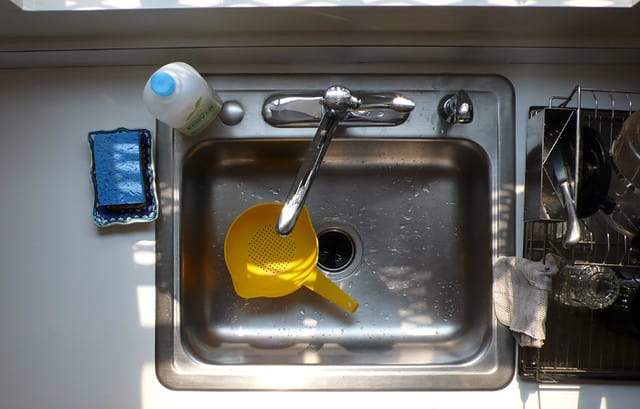If you live in a home long enough. Sooner or later you have to deal with a plumbing clog like me. In these cases usually, you’ll face a lot of standing water inside your sink bowl. You need to take immediate action to unclog your kitchen sink with standing water.
It just happened to me recently. Just moments into doing my dishes, I noticed that the water wasn’t draining from the sink. I checked to see what’s actually wrong, was there anything blocking my drain opening?
But, nothing. I switched on the garbage disposal, but that was only a temporary fix. I found no clue what is happening exactly. My sink was holding a lot of dish soap water. I had to call for professional help. But, I thought, before rushing to call a plumber should I try to do it by myself?
The answer was, yes. I can actually apply some basic steps to at least try to fix it. I had done some research and found some solutions. And one of the tricks actually worked.
I’m going to share with you some of the tricks to unclog your kitchen sink with standing water without any professional help. First, Let’s look at the trick which has worked for me.
How to Unclog a Kitchen Sink with Standing Water in Seconds
Use a pool toy to remove the standing water from the sink. Just suck up the water and pour it into a bucket as much as you can. In case of a double kitchen sink, wet a kitchen towel or use a plug and seal the garbage disposal drain. Use a plunger and position it over another drain. Pump up and down for 5 seconds. Remove the plunger and wait to see if the water drains.
If you have a single bowl kitchen sink, then you don’t need to use a plug or towel. Just use a flat-bottomed plunger for the job. With your plunger at the ready, follow the same step mentioned above.
Watch the video below to understand it clearly.
This method worked for me. But if it isn’t working for you then the blockage is not actually in the garbage disposal and drain link. It’s in the drain in and out pipe. Most of the time the blockages happen at the joints and very often it happens at P-traps. Let me share with you another trick with the p-trap that I hope will work for you.
How to Clean the P-trap to Unclog your Kitchen Sink
P-trap is the p-shaped or elbow-shaped pipe under your sink. It can block because of the food, grease and other debris. P-traps hold a limited quantity of water that forestalls sewer gases from ascending into your home.
Unfortunately, the trap’s water-catching capacity stretches out to hair, oil, flotsam and jetsam, and cleanser filth. This makes a P-trap the main area of obstructs in the sewer system.
To fix this you need to dismantling the pipe to clear out the gunk that is causing the blockage. Warning: can get somewhat muddled, so you should set yourself up with gloves, goggles and towels. At the point when you’re prepared, follow these steps to clean the P-trap:
First, you need to place a bucket underneath the pipe. This will catch any backed-up water or debris that may fall out when you open the P-trap.
Then, unscrew the connectors on the P-trap that hold the bent piece to the vertical and flat channel pipe. There ought to be a slip nut on one or the flip side of the P-trap.
Remove the P-trap and clean the pipe of all debris, grime and residue. Reconnect it and then turn on the faucet to run water down the drain.
If this still doesn’t bring any solution then the clog may be farther up the pipe. Get back under the sink again and do these steps:
Follow the same steps to remove the P-trap.
Then remove the horizontal pipe that connects the system to the wall.
You need to use a plumber’s snake, if you don’t have this tool then you can use an auger or coat hanger. Feed the tool you have into the wall pipe. When you feel an obstruction, use your tool to pull the blockage out from the pipe.
Repeat the process until you remove all flotsam and jetsam.
Reconnect the pipes and P-trap, tighten the connectors by hand. However, Do not over-tighten, as this may cause the connectors to crack.
Run hot water to flush the drain.
Then, check under the sink while the water’s running to make sure there isn’t any leaking from the pipes. If you do notice leaks, then you need to tighten all connectors again. Hopefully, this will solve your blockage.
Now, in case you’ve made it to this point and your sink actually isn’t depleting, there could be a bigger issue that needs a plumber to fix.
How to Avoid Recurrent Blockage
After you got success in unclogging your kitchen sink with standing water now it’s time to do some work to avoid future blockage. The surest strategy to keep your sink totally functional and free from blocking is to prevent food waste from entering the drain. While it is difficult to keep minuscule food particles from entering, you can make an honest effort to clean up and throw waste in the trash before putting plates and different utensils in the sink.
Running high temp water in your sink weekly will reduce the development of oil and different particles. You can also try mixing salt with hot water when cleaning the sink; this will keep it free from clogs.

If you arranged an oily supper or a sleek sweet, at that point take a stab at cleaning the plates with a paper towel. Grease and oils can develop in your drainage system. A paper towel will help forestall the development as it kills grease and oil particles prior to cleaning.
Additionally, if you live in hard water zones, you ought to consider getting a softener to not just keep progressive mineral stores from building up but also to increase the general life expectancy of your drainage pipes.
Conclusion
Here is another method: you can also use baking soda and vinegar. Take around a 1/3 cup of baking soda and place it on a dish. Take an equivalent portion of vinegar and place it in the same dish with the baking soda. The combination will fizz immediately, this is your cue to pour it down the drain immediately.
Allow the mixture to stay for 15 minutes to an hour. If you have time, you can even allow the mixture to sit overnight just to ensure that it thoroughly reacts with the residues in your sink’s drainage system. Clean the drain by running hot water. This should leave your sink fully functional and draining again.
This might solve your issue. But, trust me, the best way to unclog your kitchen sink with standing water is to try the methods I’ve described above.
If you have any further questions please leave a comment below and I’ll help you my best.
Read next: Can you put things on top of the microwave?


